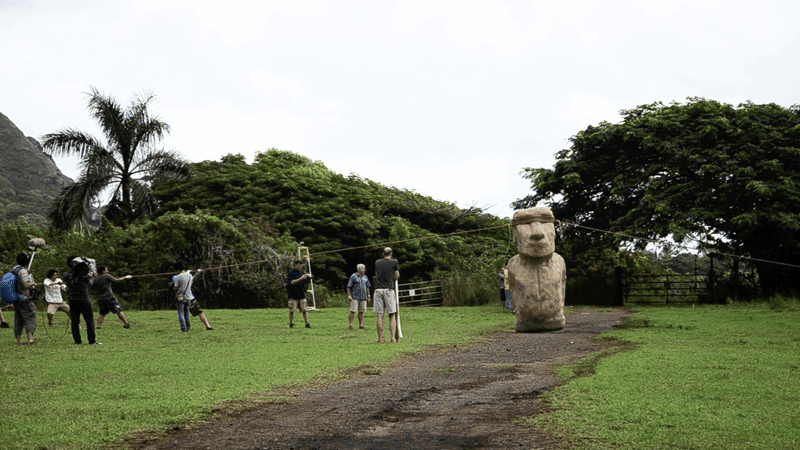Easter Island statues may have ‘walked’ thanks to ‘pendulum dynamics’ and with as few as 15 people, study finds

Easter Island’s Giant Moai Statues Could ‘Walk’ Using Simple Tools, New Study Finds
For centuries, researchers have debated how the Indigenous people of Easter Island, also known as Rapa Nui, managed to move their colossal moai statues—human-faced monoliths weighing dozens of tons—across the island. Now, a groundbreaking study offers fresh insight: the statues could have “walked” using only a small group of people, long ropes, and the principles of pendulum dynamics.
### Rethinking Moai Transportation
Anthropologists involved in the study made a surprising discovery after examining incomplete moai statues that were abandoned shortly after being quarried. These unfinished statues lacked certain details and had been crafted with a low center of mass and a distinctive forward lean—design features that likely aided their transportation.
The study, published in the November 2025 issue of the *Journal of Archaeological Science*, explains that these characteristics were intentional to facilitate moving the statues from the quarry to their final ceremonial locations.
### Virtual Reconstruction and Experimentation
The research team virtually recreated the moai and modeled their movement. They found that with just three ropes and a group ranging from five to 60 people, the statues could “walk” in steps averaging 35 inches (89 centimeters) long, effectively traveling across the rugged Rapa Nui landscape.
This finding challenges the traditional notion that relocating the moai required massive labor forces and vast resources. Instead, the authors describe a remarkably efficient method devised by the island’s inhabitants.
### Insights from the Study
Carl Lipo, professor of anthropology at Binghamton University and co-author of the study, explained the significance of their findings. “What we found is that statues were moved with very small numbers of people in an amazingly ingenious way,” Lipo told *Live Science*. “In a way that when you see it happen you’re like ‘of course they moved it that way.’”
### The “Walking” Moai Experiment
Rapa Nui was first settled around 1,000 years ago. Today, the island—covering 63 square miles (164 square kilometers)—is home to at least 962 moai statues, ranging from 3.7 feet (1.1 meters) to nearly 33 feet (9.8 meters) tall. These statues were quarried from Rano Raraku and then transported an average distance of 6.2 miles (10 kilometers) to their ceremonial sites.
The method of moving these enormous statues has long been debated. One popular hypothesis suggests the moai were “walked” upright. Supporting this idea, Lipo and his team conducted a televised experiment in 2012, where 18 people moved a 4.8-ton (4.4 metric ton) replica a distance of 328 feet (100 meters) in 40 minutes.
While this earlier experiment demonstrated the concept, it did not specifically test the exact numbers of people required. To fill in this gap, Lipo and Terry Hunt, a professor of anthropology at the University of Arizona and co-author, developed detailed 3D virtual models of 62 moai found along ancient roads, often called “road moai.”
### Key Physical Features Supporting Movement
The virtual models revealed that the road moai had a forward lean of approximately 6 to 15 degrees, shifting their center of mass to a point where the statues would topple if left unsupported. Interestingly, this center of mass was lower than in completed ceremonial moai, offering the stability needed for the sideways rocking motion used to simulate walking.
Additionally, the bases of road moai were D-shaped, acting as pivot points for each step. Unlike final moai, the road moai lacked carved eye sockets, suggesting that the statues were only fully finished once they reached their destination.
### Workforce and Movement Efficiency
The researchers analyzed the physics of this walking motion, including the moai’s mass, irregular shapes, and the force needed to start movement. Using ropes ranging from 65 to 98 feet (20 to 30 meters) long, they estimated that initiating the “walk” required 15 to 60 people, while continuing movement needed only five to 25 people. This finding underscores the remarkable efficiency of the transport method.
Tugging on the ropes generated a rocking motion, causing the statues’ bases to pivot forward. Pendulum dynamics meant that once the motion was started, each subsequent step required less effort. The team calculated that moai could “walk” at approximately 1,000 feet (310 meters) per hour, with larger moai benefitting from longer strides rather than slowing down.
On average, a moai would take around 11,000 steps to travel the 6.2-mile (10-kilometer) distance from the quarry to its final site.
### Expert Perspectives and Open Questions
Sue Hamilton, an archaeologist and professor of prehistory at University College London who was not involved in the study, praised the research as “an ingenious and worthwhile contribution to the discussion.” However, she cautioned that the data allows for multiple interpretations.
Hamilton noted that road moai might have been designed differently for varying ceremonial purposes, made by different groups, or represent a temporal style—factors that should be considered before concluding the transport method definitively.
She emphasized that while this work demonstrates the technical possibility of upright statue movement, it does not conclusively prove that this method was used historically. Other hypotheses for transporting moai remain plausible.
### Looking Ahead
In response, Lipo and Hunt wrote that critics of the walking moai hypothesis have “yet to offer plausible alternatives that account for the full range of evidence.”
As research continues, this study adds a compelling piece to the puzzle of how the remarkable Rapa Nui people engineered one of history’s most impressive feats of statue transport—walking their moai across the island with ingenuity and minimal resources.
https://www.livescience.com/archaeology/easter-island-statues-may-have-walked-thanks-to-pendulum-dynamics-and-with-as-few-as-15-people-study-finds








